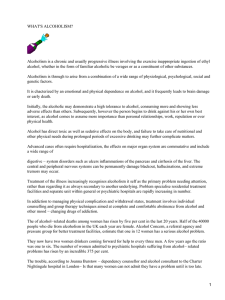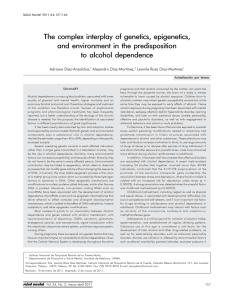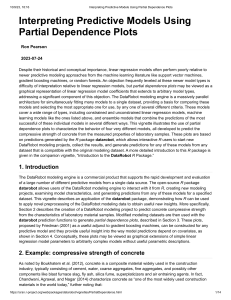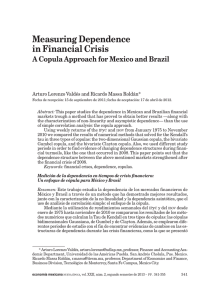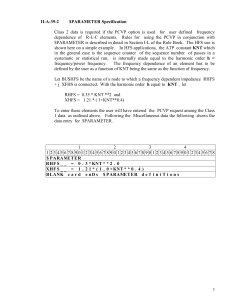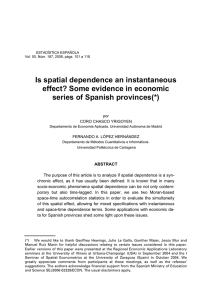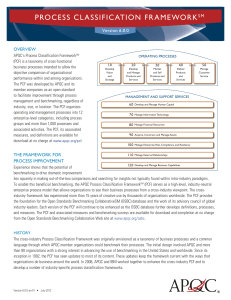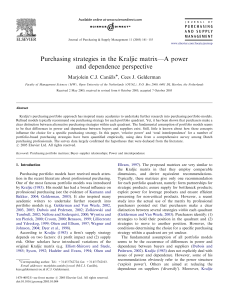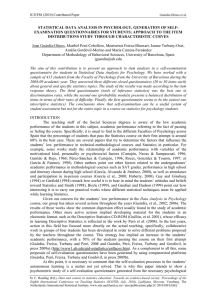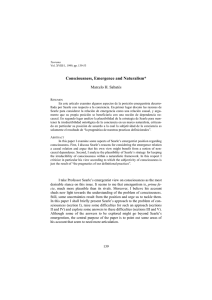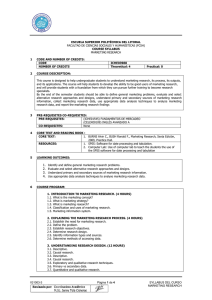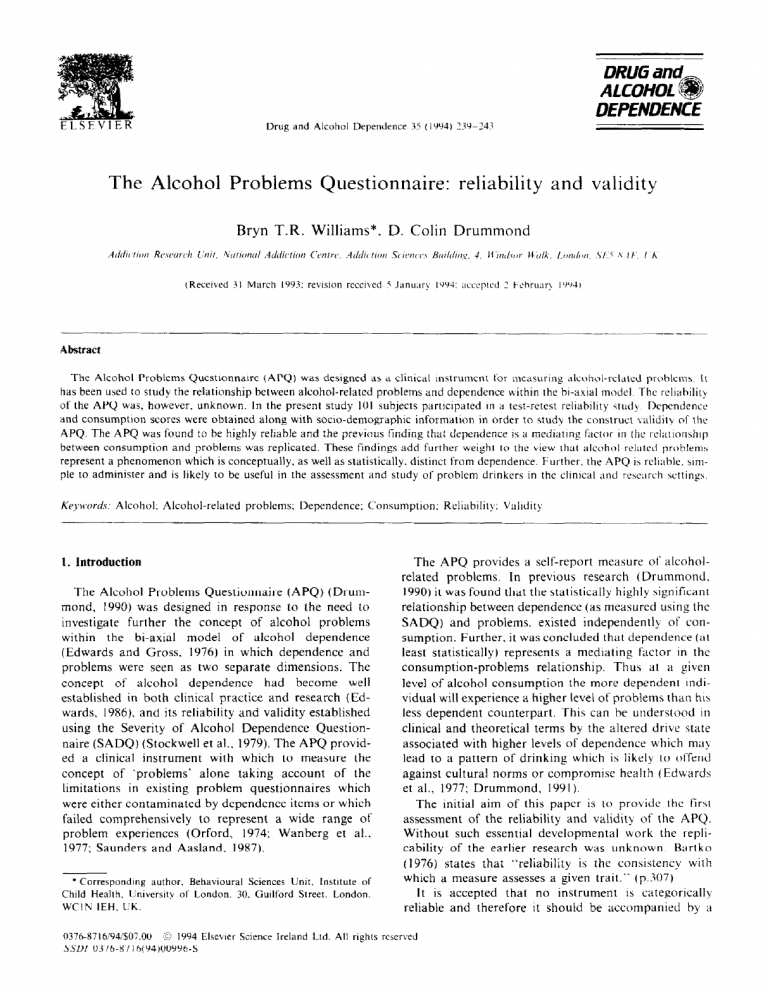
DEPENDENCE ELSEVIER Drug The Alcohol and Alcohol Problems Dependence 35 (lYY4) Questionnaire: 23Y-34? reliability and validity Bryn T.R. Williams *, D. Colin Drummond (Received 31 March 1993: revision recel\ed 5 Januar) lYY4: ;~ccpeci 7 bchruar~ IYY4) Abstract The Alcohol Problems Questionnaire (APQ) was designed as a clinical instrument for measuring alcohol-related problems. It has been used to study the relationship between alcohol-related problems and dependence within the bi-axial model. The rcliahility of the APQ was, however, unknown. In the present study 101 subjects partxipated in a test-retest reliability study. Dependence and consumption scores were obtained along with socio-demographic information in order to study the construct validity of the APQ. The APQ was found to be highly reliable and the previous finding that dependence is a mediating factor in the relaiionshlp between consumption and problems was replicated. These findings add further weight to the view that alcohol-related problema represent a phenomenon which is conceptually, as well as statistically. distinct from dependence. Further. the APQ is reliable. smlpie to administer and is likely to be useful in the assessment and study of problem drinkers in the climcal and rescarch settings. Alcohol: Ke_wmk Alcohol-related problems; Dependence; Consumption; 1. Introduction The Alcohol Problems Questionnaire (APQ) (Drummond, 1990) was designed in response to the need to investigate further the concept of alcohol problems within the bi-axial model of alcohol dependence (Edwards and Gross. 1976) in which dependence and problems were seen as two separate dimensions. The concept of alcohoI dependence had become well established in both clinical practice and research (Edwards, 1986), and its reliability and validity established using the Severity of Alcohol Dependence Questionnaire (SADQ) (Stockwell et al.. 1979). The APQ provided a clinical instrument with which to measure the concept of ‘problems’ alone taking account of the limitations in existing problem questionnaires which were either contaminated by dependence items or which failed comprehensively to represent a wide range of problem experiences (Orford, 1974; Wanberg et al.. 1977; Saunders and Aasland. 1987). * Corresponding Child Health. WCIN IEH, 0376-87 Behavioural of London, Sciences Unit, 30. Guilford 0 1994 Elsewer Science Ireland 16(94)00996-S Institute of Street. CK. 0376-87161941$07.OIl SSDl author. University London. Reliability: Validitq The APQ provides a self-report measure of alcoholrelated problems. In previous research (Drummond. 1990) it was found that the statistically highly significant relationship between dependence (as measured using the SADQ) and problems. existed independently of consumption. Further. it was concluded that dependence (at least statistically) represents a mediating Vector in the consumption-problems relationship. Thus al a given level of alcohol consumption the more dependenr individual will experience a higher level of problems than his less dependent counterpart. This can be understood in clinical and theoretical terms by the altered drive state associated with higher levels of dependence which ma> lead to a pattern of drinking which is likely to offend against cultural norms or compromise health (Edwards et al., 1977; Drummond. 1991). The initial aim of this paper is to provide the first assessment of the reliability and validity of the APQ. Without such essential developmental work the replicability of the earlier research was unknown. Burtko is the consistency with (1976) states that “reliability which a measure assesses a given trait.” (p.307) It is accepted that no instrument is categorically reliable and therefore it should be accompanied by a Ltd. All rights reserved 240 B. T. R. Williams, D. C. Drummond statement of the reliability by way of calculating the error of measurement (Anastasi, 1988). A reliability coefficient of r = 0.7 is suggested in the literature as a suitable figure on which to judge the reliability of an instrument (Guilford, 1956; Nunally, 1970). A further important factor in the case of retest reliability is a statement on the time over which the questionnaire was considered reliable (Streiner and Norman, 1989). The second aim was to replicate the findings of Drummond (1990) in which the relationship between problems, dependence and consumption in which it was previously found that the consumption-problems relationship was largely mediated by dependence, and by doing so develop the construct validity (Cronbach and Meehl, 1955) of the mediating influence of dependence on the consumption-problems relationship. 2. Method 2.1. Subjects In the UK, 101 subjects presenting to alcohol treatment centres were approached on a ‘next patient’ basis to participate in this study. Subjects were inpatients or hostel residents, who had presented primarily for treatment of drinking problems. Only subjects who had completed detoxification were included in the study. Those showing signs of organic impairment were excluded. Because of incomplete data, six further subjects were excluded from the analysis. This left a sample of 95 suitable for analysis. The male:female ratio was 4:l (male, n = 73; female, n = 22). The mean age of the sample was 41.6 (SD. = 10.72) ranging from 22 years to 74 years. Of the sample, 38% were single, 34% separated or divorced, and 28% either married or cohabiting. Those in full or part-time employment formed 3 1% of the sample, whilst 45%) were unemployed. Of this latter group, threequarters stated they were not seeking work. Based on the classification of occupations of the Registrar General (Office Of Population Censuses and Surveys, 1980), the following distribution was established: social class I and 11, n = 21 (22.1%); III, nonmanual, n = 17 (17.9%); III, manual, n = 19 (20%); IV, n = 11 (11.6%); V. n = 15 (15.8%); those unemployed, retired, or studying made up the remaining 12.6% of the sample. Of the subjects, 58% had at least one child. 2.2. Procedure Subjects were recruited if they were participating in a rehabilitation programme or remaining within their institution for more than two weeks following initial contact. This was to allow for the retest of the APQ to be conducted. The APQ, SADQ and socio-demographic information were collected on the first occasion (test one). Fourteen days was selected as the time between the / Drug Alcohol Depend. 35 i 1994) 239-243 two tests, when subjects were asked to complete the APQ for a second time. To enhance the validity of responses subjects were ensured of confidentiality; the interviewer who was present on both occasions had to compile a confidential list of names in order to match the correct retest questionnaire to the appropriate subject. Retests were as far as possible conducted under similar circumstances, Whilst the interviewer was present to answer questions, subjects were encouraged to complete the questionnaires quickly and without too much introspection. 2.3. Measures The APQ has previously been described in detail (Drummond, 1990). It contains 44 items, with eight problem domains (friends 4, money 4, police 3, physical 7, affective 5, marital 9, children 4, work 8). All questions apply to the last six months and subjects are asked to indicate by ticking ‘yes’ or ‘no’ as to whether the question is applicable to them. The first 23 items are applicable to all subjects and are referred to as the ‘common’ subscale. The three remaining subscales including marital, children, and work are only applicable to subgroups of subjects. The SADQ has also been described in detail (Stockwell et al., 1979). In brief it consists of 20 items measuring various aspects of the dependence syndrome. Of the items, four refer specifically to consumption, asking subjects to state how much they have ever consumed in a typical day (l/4 bottle, 112 bottle, 1 bottle or 2 bottles). The SADQ items are rated on a 4-point scale representing the frequency of experiencing each symptom or event (nearly or almost never’ 0; ‘sometimes’ 1; ‘often’ 2; nearly always’ 3). Responses are summed to a possible score of 60, with 12 points being related solely to quantity and frequency of consumption. The sociodemographic information was compiled from a selfcompletion questionnaire. 3. Results 3.1. Reliability study To assess the reliability of the APQ, a reliability coefficient was derived by computing the estimated true variance in ratio to the observed variance of the trait using the SPSS/PC+ ‘Reliability’ procedure, with the ANOVA option. The results for the APQ common score and subscales are presented in Table 1. The results confirm that the APQ common score and the marital and work subscales have a high reliability. The children subscale did not yield a high reliability coefficient and this finding supports Drummond (1990) who concluded that social acceptability made answering questions about children problematic, an issue to be addressed in the discussion. 6. T. R. Williams, Table I Reliability of the Alcohol Subscales Problems D. C. Drummond/ Drug Alcohol Depend. 3.5 ( IYY4) ,?3Y-243 Questionnaire Test one ANOVA Test two Reliability Mean S.D. Mean S.D. F P 15.19 3.03 5.10 3.46 2.37 I.15 (4.55) (0.99) (1.87) (1.44) (1.60) 15.14 3.00 5.16 3.45 2.37 1.19 (4.91) (0.89) (1.64) (I .40) (1.56) (1.04) 0.06 I 0.113 0.259 0.01 I 0.000 0.888 0.805 0.73x 0.612 0.915 I 000 0.348 0.9266 0.6999 0.X6X5 0.x729 0.9329 0.9547 Marital 5.85 ( I .95) 5.96 (2.24) 0.236 0631 0.9093 Children 2.57 (1.34) 2.26 (I .42) 0.92 I 0.34x 0.5 I69 Work 4.50 (2.14) 4.46 (2.02) 0.015 0.904 0.x233 APQC Friends Physical Affect Money Police (1.03) 3.2. Replication studs: relationship between consumption, dependence ‘41 and alcohol-related problems In order to establish the construct validity concerning the structural relationship between consumption, dependence and problems, the SPSS/PC+ correlations and partial correlations and multiple regression procedures were used to analyze the APQ, SADQ and sociodemographic data obtained at test one. Alpha level of 0.05 was selected in view of the sample size. A mean APQ common score (APQC) of 15.19 (S.D. = 4.55) was found, ranging from 4 to 23 (maximum score possible = 23). In comparison with the study of Drummond where the mean APQC was I 1.6 (S.D. = 4.50), the current study includes subjects with a higher number of problems. The mean SADQ score was 35.45 (S.D. = 14.37). ranging from 0 to 58 (maximum score possible = 60). Similarly the current study includes a more dependent group compared to Drummond’s SADQ score of 25.20 (S.D. = 14.8). The Pearson product moment correlation coefficient between the APQC and the SADQ (less consumption items) was highly significant (r = 0.51; P = 0.0005). Following the analytic procedure used by Drummond, the four consumption items in the SADQ (maximum possible score = 12) were calculated for drinking quantity (consumption) and compared against dependence (SADQ -- Less consumption items) (maximum possible score = 48). The correlation between these two items was highly significant (r = 0.56; P = 0.0001) as was the correlation between consumption and the APQC (r = 0.41; P = 0.0001). The correlations and partial correlations between these measures are presented in Figs. I and 2. When controlling for alcohol consumption, as measured by the four consumption items in the SADQ, there is a significant partial correlation between the APQC and SADQ (less consumption items) (r = 0.37; P = 0.0002). However, as previously found. the partial coefficient correlation between problems and consumption. controlling for dependence, is low (r = 0.18; P = 0.08 1) This result supports the conclusion that whilst the quantity of alcohol consumed is correlated significantly with dependence and problems, the significant relationship between problems and dependence is largely independent of level of consumption, and that dependence mediates the consumption-problems relationship. 3.3. Predictors qf‘ problems The current study also sought to replicate the relationship between the APQC and demographic variables using a forced entry multiple regression analysis. Aa with the study of Drummond, consumption. dependence, sex, age and social class were included in the analysis. For the socio-economic variable subjects were divided into two groups, I and II (high social group) and III-VI (low social group). The dependence score accounted for the greatest relationship with problems (0 = 0.38; P = 0.0005). followed by social class not Consumption did P = 0.0062). (/3 = 0.25; significantly predict problems (p = 0.16; N.S.). Nor did age and sex predict the APQC score (Age, 0 = 0.07: Dependence 51 .56 i\ Consumption Problems .41 Fig. 1. Pearson problems. corrclatlons between dcpendcncc. consumption and 242 Dependence .44 .37 /\ Problems Consumotion 18 Fig 2 Partial correlations between dcpcndcnce. consumption and problems. N.S.; Sex, P = 0.13; N.S.). Dependence was the strongest predictor of alcohol-related problems; in contrast however, the current study did not find sex to be an important predictor of alcohol-related problems. Therefore, as in previous analyses. the more dependent, lower socio-economic class groups were found to have a significantly higher level of alcohol-related problems. 4. Discussion It is intended in the discussion to emphasize how the results support previous findings and to highlight the implications of the APQ in future research and clinical work. This study set out to establish the reliability of the APQ and to develop the construct validity concerning the structural relationship between consumption. dependence and problems. Both studies have produced positive results suggesting that the APQ is a reliable instrument which consistently measures the concerns of problem drinkers. Highly satisfactory reliability coefficients were established for the APQC, marital and work subscales. However the results were not significant for the children subscale. During the development of the APQ, Drummond (1990) discovered that subjects with children were failing to respond to questions concerning their children, which may be interpreted as being socially unacceptable. This may account for the poor reliability result obtamed in this study. This point is substantiated further by considering that 58% of the subjects reported on the socio-demographrc data that they had at least one or more children. Yet on the APQ less than one third of these subjects elected to answer the subscale. This raises the question as to whether this subscale should be dropped from the questionnaire. The APQ is an effective instrument for assessment and measurement of alcohol-related problems. It is sim- pie to administer, requires approximately 10 mm to complete and is easily understood by patients. In terms of research the APQ contributes to an understanding of alcohol-related problems. and gives further credibility to inclusion of alcohol problems in classificatory systems. The results from the replication study support previous conclusions that alcohol dependence and alcoholrelated problems are strongly related (Skinner, 1981: Sadava, 1985; White. 19871, and that problems are statistically independent of consumption (Drummond. 1991). It can be concluded from the results that the relationship between consumption, dependence and problems has been replicated using the Alcohol Problems Questionnaire. Whilst consumption, dependence and alcohol-related problems are highly correlated with one another. the partial correlations demonstrate that the relationship between problems and dependence is largely independent of consumption. This provides further evidence that consumption exists as a statistically, as well as conceptually, distinct axis from dependence and problems. Similar findings have been obtained in a German clinical sample and a general population sample (Drummond. 1991). The higher mean APQC score found in this sample compared to that of Drummond may be due to the inclusion in this study of more inpatients and those in residential rehabilitation, The sample in this study also had a higher mean level of dependence as measured by the SADQ. This may have served to increase the likelihood of finding a stronger relationship between dependence and problems and a weaker relationship between consumption and problems: an earlier study in a genera! population sample of drinkers had found that these relationships were more pronounced in more dependent drinkers (Drummond. 1991). Nevertheless. the results of this study add further weight to the statistically mediating effect of dependence in the consumptionproblems relationship, in that similar resuhs were found in a different sample of problem drinkers recruited from treatment centres which were different from those selected by Drummond in the previous study. Conceptually the bi-axial model focusmg on dependence and problems. allowed for a drinker to develop problems without necessarily being dependent. Some evidence in the general population studies (Makela and Simpura, 1985; Hilton. 1987) suggests that problems related to alcohol misuse are more prevalent than dependence per se. However, Drummond (1990) suggests it is ‘understandable’ that a higher degree of problems is likely to emerge the more dependent the individual becomes. Having established that problems and dependence are conceptually distinct phenomena (as suggested by the bi-axial model) it has become possible to explore how ‘dependence’ and ‘problems’ relate empirically. 5. Acknowledgements Edwards. G.. Gross. M.M.. Alcohol-Related We would like to express our appreciation to Sharon Hoffman for her assistance in data collection. Equally this study would have been impossible without the tremendous help and co-operation of staff and patients from Clouds House, Wiltshire; St. Bernard’s Alcohol Unit, Ealing; The Turning Point organization throughout England: B-Sharp, Bromley-by-Bow; West Park Hospital, Epsom; and St. Ann’s Detoxification Unit, Leeds. We are grateful to Toby Andrew and Colin Taylor for their advice and help with the statistical analysis. and to Griffith Edwards and Colin Taylor for comments on earlier drafts. This research was funded by an MRC programme grant. World Keller. M.. Moser, J. and Room, R Disabilities. Health Orgamzatlon. Guildford. J.P. (1956) WHO Offser ( 1~771 Puhl~cat~on Y,,.??. McGraw-Hill. Nc\* Geneva. Psychometric Method\. York. HIlton. M.E. (19x7) Drinking patterns and drlnhlnp prohlcm\ results from a general populatmn hurxe! AIcoh~~l’(‘l~n. 111IYX4 t.up Kc\ I I. 175-177. Makela, K. and Slrnpura. J. (IYXS) Expcrlcnce\ a function of xnual trelatcd to dl-inhlng ;I\ intake hy xx and age IIrug ~2lcohol I)rpcnd 15. 3X’)-404. Nunally. J.C.. Jr. (1970) introduction Chapter Office 5. McGraw-Hill. of PopularIon Occupations. Orford. Ccnsuscs and Sur\c!\ HMSO. J (lY74) to I’\ychol~>gc,~I Mearul-emenr. Ne% York. I%XO. (‘l,~\\llicatlon~ (11 London A prospcctne xtudy of rhc relati~x~shlp herwccn marital factor\ and the outcome of treatment 1’01.~lcohol~\n~ Ph.11 Thesla. Umver\lt) of London. Sadava. S.W. (19X5) Problem behaviour theory and consumption L‘OII- sequences of alcohol use. J. Stud. Alcohol Jh. iY-107 6. References Saunder\. Consumption. ?\nastasl. A. (19Xx) Psychological Publishing Company. Bartko. J.J. and Carpenter. of reliability. (‘ronbach. W.T. J. Nerv. Ment. L.T. and Testing, 6th. Edltion. Macmillan New York. Meehl. Dis.. Vol. P.E. 11955) 163. 5, 307-317. Construct 0.C‘. (1990) The dence and alcohol-related Addict. and Health. relationship problems in a clinical population. depenBr. J. D.(‘. M.D. Alcohol-Related Thesis. University Problems and Public of Glasgow. Icdwards. G. and Gross. slonal deacrlprlon 1058-1061. of Br. J. Addict. M.M. a (1976) clinlcal XI. I71 -183. Alcohol syndrome. ( and RankIn. to mea\urc H \e\c‘rlt> 01 Scale\. Press. Gale. L. and Milofskq. E.S. (19X2) Natural between dlffcrcnt hl\tor) ol dlagno<tlc 43. 216-232 Horn. J.L. and Foster F.M.A. (1977) A diffcrcntial assessment model for alcoholism: the scaler of the .ilcohol u\e in- dependence: Br. K.W.. thclr ~mc;~- 74. 7Y-X7 male alcoholism: II The relationship Wanberg. ;thu\c G.R. (19x9) Health Measurement dimensions. J. Stud. Alcohol I:dwards. G. (19X6) The alcohol dependence syndrome: a concept ah a stimulus to enquiry. G.E., AlLohol oI.;I Scrcenlng III- 76. h3-7h of a questionnaire Br. J. Addict. Streiner. D.L. and Norman. University Br. _I. Addlcr R.. Edwards. G. Taylor. (1979) The development Vaillant. (1991) C’crllah~~t-:IIIL~I’roJcct of alcohol PrImal-y syndrome\ surcment and correlate>. Oxford WHO 01. Pcrxms \b~th H,irmful Health Ot-ganlzat~on. Genc\;~ alcohol dependence. between alcohol X5. 357-366. Drummond. strument. World Stockwell. T. Hodgson. validity psychological tests. Psychol. Bull. 52. 28 I-302. IIrummond. and Treatment Report on Phase I. De\elopmcnt Skinner. H.A. (IYXI) (1976) On the methods and theory ( IYX7) J.S. and Aaaland. 0.C;. on Identllicatlon Med. proviJ. I. ventory. J. Stud. Alcohol 45. 34&34X. White H.R. (1987) Longitudinal problem drinking stabilit) and dimcn\lonal \tructure in adolescence. J Stud. Alcohol 1X. 541-550 of
